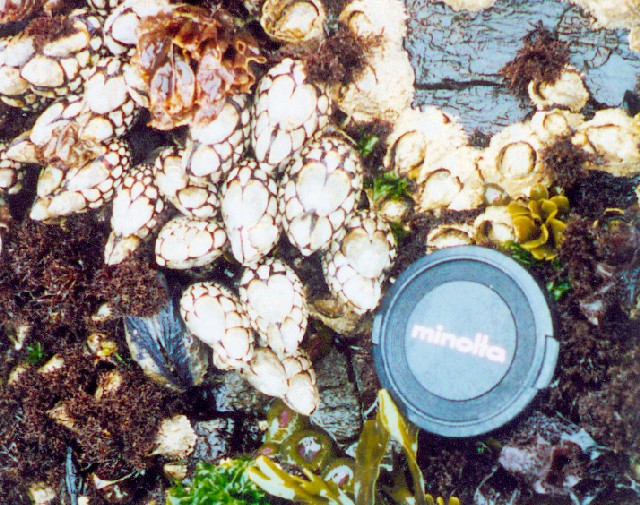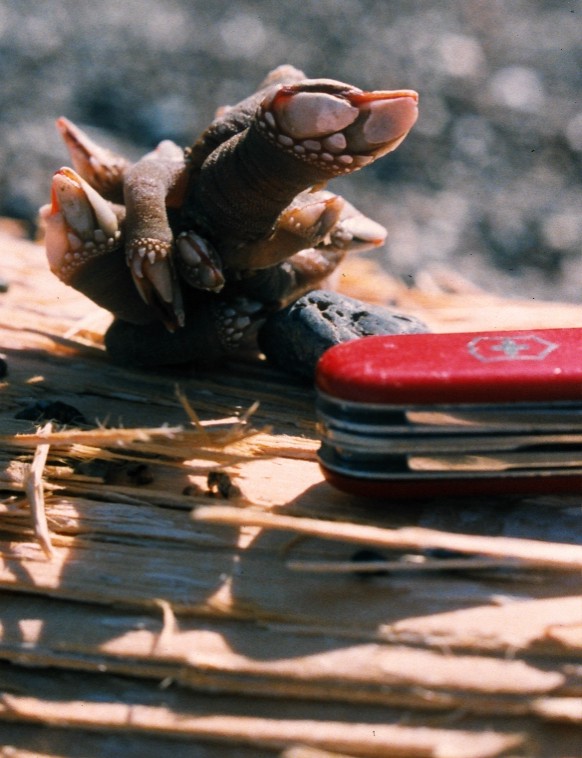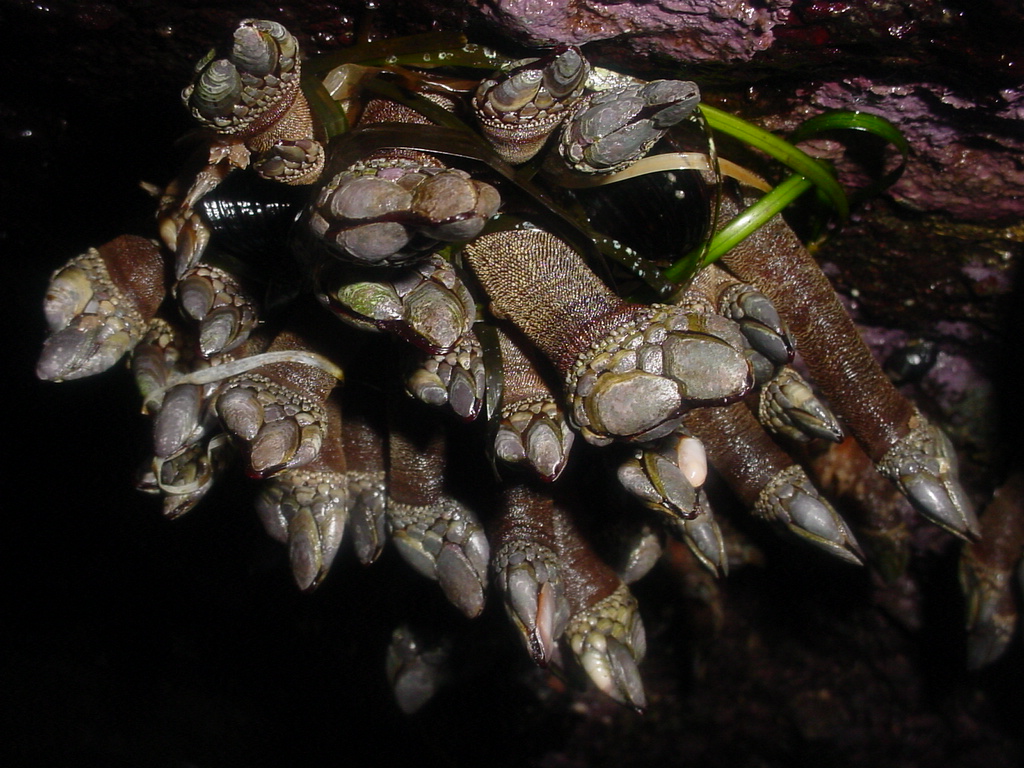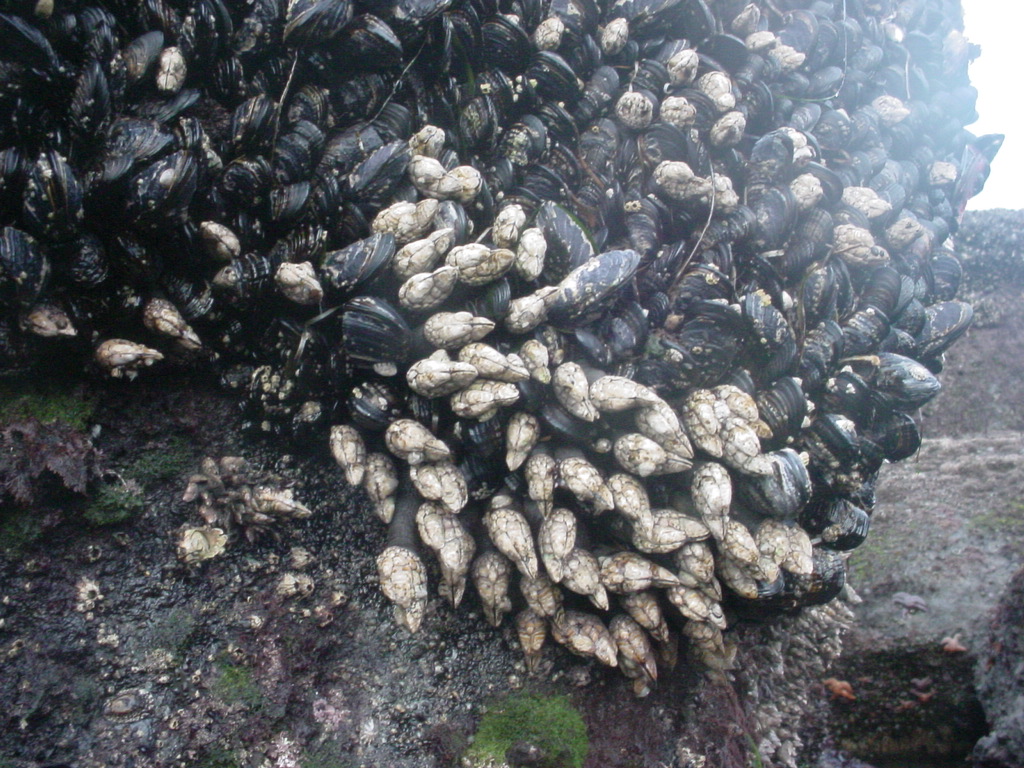Pollicipes polymerus (Sowerby, 1833)Goose Neck Barnacle, Leaf Barnacle |
|
| Synonyms: Mitella polymerus |  |
| Phylum Arthropoda
Subphylum Crustacea Class Maxillopoda Infraclass Cirripedia Superorder Thoracica Order Pedunculata Suborder Scapellomorpha Family Scalpellidae |
|
| Rosette of Leaf Barnacles (Pollicipes polymerus) at Swirl Rocks, WA. Approximate length of capitulum is 3 cm. | |
| (Photo by: Melissa McFadden, June 2002) | |
How to Distinguish from Similar Species: There is a pelagic goose barnacle, Lepas anatifera, frequently found in the Pacific Northwest that looks somewhat similar to M. polymerus, however is has fewer plates and only occurs in the open sea and on driftwood washed ashore. There is a closely related European species, Pollicipes pollicipes, which is cooked and served as a delicacy. However, it is now in short supply and M. polymerus has been exported from British Columbia to Portugal and Spain.
Geographical Range: This species of barnacle is found as far north as Southeast Alaska to Baja California in the south.
Depth Range: P. polymerus occurs in the high to middle intertidal zones.
Habitat: This barnacle prefers open, surf-swept coastlines. It has also been reported to occur on other barnacles on the skin of Humpback Whales.
Biology/Natural History:
This species
feeds by growing outward so that it can extend its cirri
in a fan oriented perpendicular to the backwash of the waves.
Small
particles of detritus and tiny crustaceans get caught in the cirri,
which
are subsequently eaten. Predators of M. polymerus include
the ochre
sea star (Pisaster ochraceus) and the
Glaucous-winged Gull (Larus
glaucescens).
M. polymerus directly competes with the California
Mussel (Mytilus californianus) and can
often out-compete them, but they are more vulnerable to predation by
gulls.
M.
polymerus
often grows in tight bunches (rosettes) which make them more
resistant to predation. In the Puget Sound, Goose Neck
barnacles
breed from April to October, peaking in July. Individuals are
hermaphroditic,
but will always cross-fertilize. Each sexually mature
individual
may produce up to four broods per year, with up to 20,000 developed
young
per brood. The young aggregate at the base of the adults,
where their
survival rate increases. Within one month they are able to
attain
independence. Current research includes energy flow within
ecosystems
containing M. polymerus and the accumulation of
toxins within the
mussel tissue.
Note: The genus Pollicipes has an unusual
distribution
of W. Europe, NW Africa, and W North and Central America (Newman and
Killingsley,
1985; Newman 1987, 1992). Newman attributes this distribution
to
a relict of the Tethys Sea.
References:
Dichotomous Keys:
Kozloff, 1987, 1996.
Smith and Carlton, 1975
General References:
Brandon
and Rokop, 1985
Carefoot,
1977
Gotshall,
1994
Harbo,
1999
Hinton,
1987
Johnson
and Snook, 1955
Kozloff,
1993
McConnaughey
and McConnaughey, 1985
Morris
et. al. 1980.
Niesen,
1994
Niesen,
1997
O’Clair
and O’Clair, 1998.
Ricketts
et al., 1985
Scientific Articles:
Newman, W.A., 1987. Southern hemisphere endemism among the
barnacles:
Explained in part by extinction of northern members of amphitropical
taxa?
Bulletin of Marine Science 4(2): 603-619
Newman, W.A., 1992. Biotic cognates of eastern boundary conditions in the Pacific and Atlantic: Relicts of Tethys and climatic change. Proceedings of the San Diego Society of Natural History 16: 1-7
Newman, W.A. and J.S. Killingsley, 1985. The north-east Pacific intertidal barnacle Pollicipes polymerus in India? a biogeographical enigma elucidated by 18O fractionation in barnacle calcite. Journal of Natural History 19(6): 1191-1196
Wootton, J.T., 1993. Size-dependent competition--effects on the dynamics vs the end-point of mussel bed succession. Ecology 74:1 pp. 195-206
| Return to: | |||
| Main Page | Alphabetic Index | Systematic Index | Glossary |
General Notes and Observations: Locations, abundances, unusual behaviors, etc.:

Pollicipes polymerus at Slip Point, Clallam Bay,
WA. Photo
by Dave Cowles, 7-1997

A cluster of Pollicipes polymerus under a boulder
at Cape Flattery.
Photo by Dave Cowles, July 2004

Gooseneck barnacles often compete with California
mussels for space (and if undisturbed, the mussels usually
win).
Photo by Dave Cowles, Shi Shi Beach, Sept 2005
Authors and Editors of Page:
Melissa McFadden (2002): Created original page
Edited by Hans Helmstetler: 10-2002
Edited by Dave Cowles, 2005, 2007